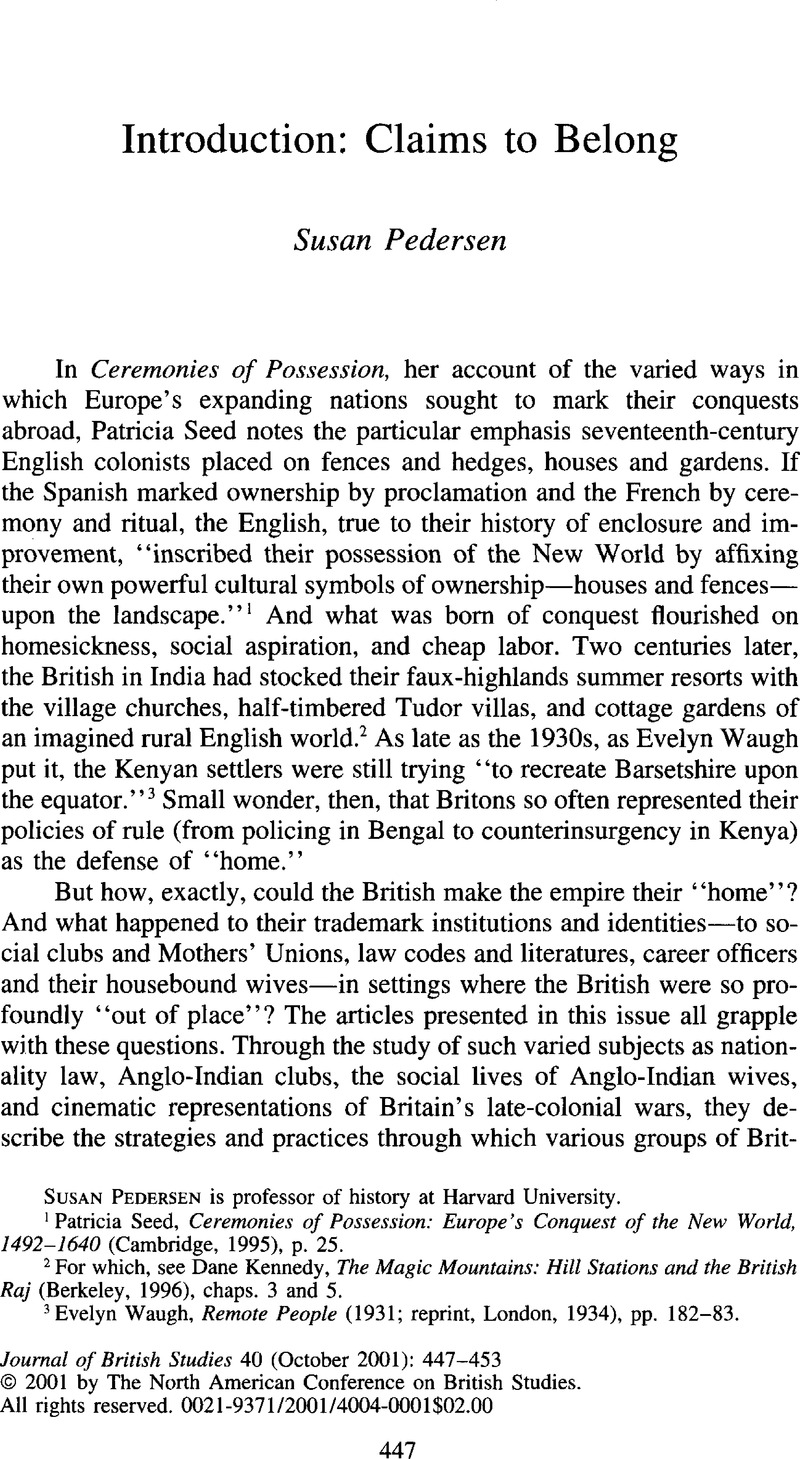No CrossRef data available.
Article contents
Introduction: Claims to Belong
Published online by Cambridge University Press: 10 January 2014
Abstract

- Type
- Introduction
- Information
- Journal of British Studies , Volume 40 , Issue 4: At Home in the Empire , October 2001 , pp. 447 - 453
- Copyright
- Copyright © North American Conference of British Studies 2001
References
1 Seed, Patricia, Ceremonies of Possession: Europe's Conquest of the New World, 1492–1640 (Cambridge, 1995), p. 25Google Scholar.
2 For which, see Kennedy, Dane, The Magic Mountains: Hill Stations and the British Raj (Berkeley, 1996), chaps. 3 and 5Google Scholar.
3 Waugh, Evelyn, Remote People (1931; reprint, London, 1934), pp. 182–83Google Scholar.
4 There is now a good deal of historical work on British constructions of—and attempts to reform—Indian gender relations. For a useful summary of nineteenth-century patterns, see Metcalf, Thomas R., Ideologies of the Raj (Cambridge, 1995), esp. pp. 92–107CrossRefGoogle Scholar.
5 Again, this literature is now substantial, but for the cases mentioned here, see Sharpe, Jenny, Allegories of Empire: The Figure of Woman in the Colonial Text (Minneapolis, 1983)Google Scholar; Inglis, Amirah, “Not a White Woman Safe”: Sexual Anxiety and Politics in Port Moresby, 1920–1934 (Canberra, 1974)Google Scholar; Sayer, Derek, “British Responses to the Amritsar Massacre,” Past and Present, no. 131 (May 1991): 130–64Google Scholar.
6 Papers Laid before the Royal Commission by Governor Eyre, (PP), 1866, vol. 30, p. 478Google Scholar. I am grateful to Elaine Kwok for bringing this letter to my attention.
7 Sinha, Mrinalini, “‘Chathams, Pitts, and Gladstones in Petticoats’: The Politics of Gender and Race in the Ilbert Bill Controversy, 1883–1884,” in Western Women and Imperialism: Complicity and Resistance, ed. Chaudhuri, Nupur and Strobel, Margaret (Bloomington, Ind., 1992), esp. pp. 106–7Google Scholar. Note, e.g., Mary Poovey's brilliant early analysis of the military and imperial imagery pervading Nightingale's rhetoric. Poovey, Mary, Uneven Developments: The Ideological Work of Gender in Mid-Victorian England (Chicago, 1988), pp. 194–98Google Scholar.
8 Stark, Freya, The Valleys of the Assassins and Other Persian Travels (London, 1934), p. 69Google Scholar.
9 Callaway, Helen, Gender, Culture and Empire: European Women in Colonial Nigeria (Urbana, Ill., 1987)CrossRefGoogle Scholar.
10 See esp., Disraeli, Benjamin, Sybil (1845; reprint, Harmondsworth, 1980), esp. pp. 480, 483Google Scholar.
11 For the twentieth century, see esp. Anderson, David M. and Killingray, David, eds., Policing and Decolonisation: Politics, Nationalism and the Police, 1917–1965 (Manchester, 1992)Google Scholar.
12 University of Liverpool Library, Rathbone Papers XIV. 1.8 and XIV. 1.9, EFR to her family, 3 February and 7 February 1932; and Hansard Parliamentary Debates, 5th ser., vol. 265 (29 April 1932)Google Scholar, cols. 744–49.
13 I am indebted to Caroline Elkins for my understanding of counterinsurgency and pacification strategies in Kenya. See Elkins, Caroline, “Detention and Rehabilitation during the Mau Mau Emergency: The Crisis of Late Colonial Kenya” (Ph.D. diss., Harvard University, 2001)Google Scholar.




